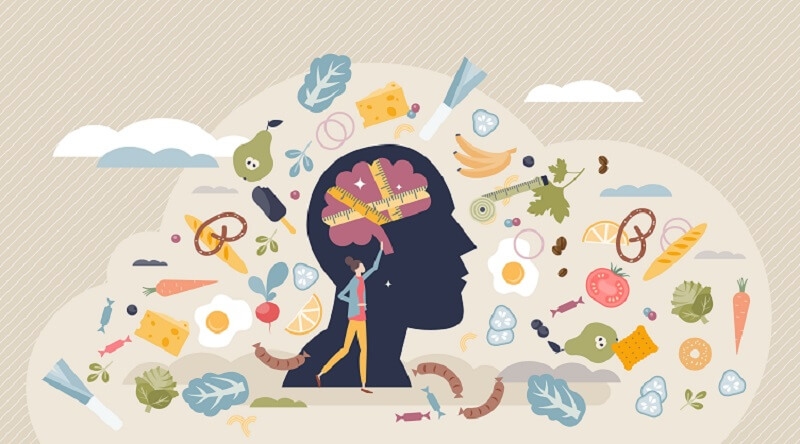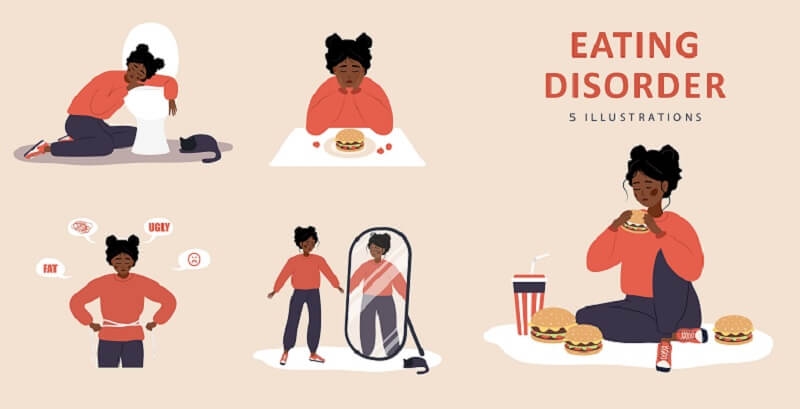Types of Eating Disorders - Symptoms and Treatment

Eating disorders are complex and potentially life-threatening mental health conditions affecting millions worldwide. A distorted relationship identifies these disorders with food and body image and often has severe physical and psychological consequences. In this detailed exploration, lets learn what eating disorders are, the signs and symptoms that accompany them, their potential causes, the various types of eating disorders, and how to recognize them. We will also take a closer look at the available treatments and therapies and discuss practical ways to help someone struggling with an eating disorder.
What is an eating disorder?
Eating disorders are a category of mental health disorders centered around unhealthy eating habits, a skewed body image, and an overwhelming preoccupation with food. These disorders lead to severe physical and emotional distress; if left untreated, they can be life-threatening.
What are the signs of an eating disorder?

The signs of eating disorders can be subtle and overt, varying according to the type. Nonetheless, some common red flags include:
- Drastic weight changes: A noticeable and unexplained change in body weight, whether extreme weight loss or rapid weight gain.
- Preoccupation with food: An intense focus on food, calories, and dieting, often excluding other aspects of life.
- Social avoidance: Avoidance of social situations that involve food, as these may trigger anxiety or fear of judgment.
- Altered eating habits: Changes in eating patterns, such as restrictive eating, binge eating, or purging through vomiting or laxative use (in the case of bulimia).
- Negative body image: Frequent self-criticism and dissatisfaction with body size and shape.
- Excessive exercise: Using exercise to control or lose weight is often beyond what is considered healthy.
- Bathroom visits: Frequent trips to the bathroom immediately after eating, usually associated with purging (in the case of bulimia).
- Rituals and rules: The development of strict regulations or conventions around eating, such as eating only certain foods or at specific times.
What causes eating disorders?
Eating disorders are multifactorial, and their causes are often complex. While it can vary from person to person, some common contributing factors include:
- Genetics: There is evidence of a genetic component in some eating disorders. A family history of eating disorders can increase the risk.
- Environmental factors: Cultural and societal pressures, especially those emphasizing thinness and beauty, can contribute to developing eating disorders. Additionally, exposure to traumatic events, such as abuse, can be a factor.
- Low self-esteem: Negative self-perception and a lack of self-worth can play a significant role in developing eating disorders.
- Dieting and weight loss: Dieting and a desire to lose weight can lead to unhealthy eating habits and a heightened risk of developing an eating disorder.
Different Types of Eating Disorders
Eating disorders encompass a range of conditions, each with its own set of characteristics and behaviors. The main types include:
- Anorexia Nervosa: Individuals with anorexia nervosa have an intense fear of gaining weight and often restrict their food intake to severe malnutrition. This can result in emaciation, extreme weakness, and other health complications.
- Bulimia Nervosa: Bulimia is characterized by recurrent episodes of binge eating, followed by purging through behaviors like vomiting, excessive exercise, or laxative use. This cycle of overeating and purging can have detrimental effects on both physical and mental health.
- Orthorexia: Orthorexia is an obsession with eating only "healthy" or "clean" foods to the detriment of overall well-being. Individuals with orthorexia may become fixated on the purity and quality of a balanced diet, which can lead to nutritional imbalances.
- Avoidant/Restrictive Food Intake Disorder (ARFID): ARFID is characterized by limited food preferences, often driven by sensory aversions to specific tastes, textures, or smells. This can lead to a highly restricted diet that may need more essential nutrients.
- Other Specified Feeding or Eating Disorder (OSFED): OSFED encompasses disordered eating behaviors that do not fit the criteria for the specific disorders mentioned above but still pose a significant threat to health. It is sometimes called atypical anorexia, bulimia, or binge eating disorder.
Six Types of Symptoms

The symptoms of eating disorders can be wide-ranging and may include:
- Physical changes: Extreme weight fluctuations, including emaciation in anorexia or weight gain in binge eating disorder.
- Mental preoccupation: Constant preoccupation with food and body image can lead to anxiety and depression.
- Social isolation: Withdrawal from social situations, particularly food-related ones, to avoid judgment or anxiety.
- Loss of menstruation: In females, the loss of menstrual periods, known as amenorrhea, is a common symptom of anorexia.
- Physical health complications: Deteriorating physical health, such as dental problems, hair loss, lack of food necessary for heart health, and digestive problems.
- Distorted Body Image: People with eating disorders often have a distorted perception of their bodies. They may see themselves as overweight even when they are underweight or engage in excessive exercise or other behaviors to try to achieve an unrealistic body shape
How do you know if you have an eating disorder?
Recognizing an eating disorder in yourself or someone else can be challenging, as individuals often attempt to hide their symptoms. If you suspect an eating disorder, it is vital to seek professional help. Diagnosis and treatment should be conducted by a healthcare provider experienced in eating disorders. If you or someone you know exhibits several of the signs and symptoms mentioned earlier, it's essential to take the matter seriously and consult a healthcare professional. Early intervention can significantly improve the chances of successful recovery.
Eating Disorder Treatment & Therapy Options
The treatment of eating disorders typically involves a multidisciplinary approach, as these disorders affect both the body and mind. The following are some of the treatment options:
- Medical Monitoring: Medical care may be necessary for those with severe physical health complications to stabilize and improve overall health.
- Nutritional Counseling: Nutritional therapy helps individuals reestablish healthy eating patterns and develop a balanced relationship with food.
- Psychotherapy: Psychotherapeutic approaches such as Cognitive-Behavioral Therapy (CBT) and Dialectical Behavior Therapy (DBT) are often used to address the underlying psychological factors contributing to the disorder.
- Medications: In some cases, medications may be prescribed to manage symptoms such as depression, anxiety, or binge eating. These are typically used in conjunction with psychotherapy.
- Support Groups: Joining support or therapy groups can give individuals a sense of community and understanding, allowing them to share their experiences and challenges with others on the path to recovery.
How to Help Someone with an Eating Disorder
Supporting someone with an eating disorder can be emotionally challenging, but your support is crucial. Here are some steps to consider:
- Open communication: Encourage open and non-judgmental communication. Please express your concern and let the individual know you care about their well-being.
- Seek professional help: Encourage the person to seek professional treatment. Offer to help them find a qualified therapist or treatment center if needed.
- Educate yourself: Learn as much as possible about eating disorders to better understand the condition. This can help you empathize and offer more informed support.
- Avoid body comments: Refrain from making comments about their appearance, food choices, or weight, as these can be triggers for those with eating disorders.
- Be patient: Recovery from an eating disorder is a journey that can be long and challenging. Be patient, understanding, and supportive throughout the process.
Also Read: Food For Fitness: Discovering the Best Fuel For Your Life
Conclusion
Eating disorders are severe mental health conditions that require timely intervention and professional treatment. Recognizing the signs, seeking help, and supporting those affected is essential. With proper treatment, individuals struggling with eating disorders can work towards recovery and regain a healthier relationship with food and their bodies. If you or someone you know is facing an eating disorder, don't hesitate to contact a healthcare provider or mental health professional for assistance. Remember that early intervention and a robust support system can significantly affect recovery.
This content was created by AI
-1717753922-r.jpg)